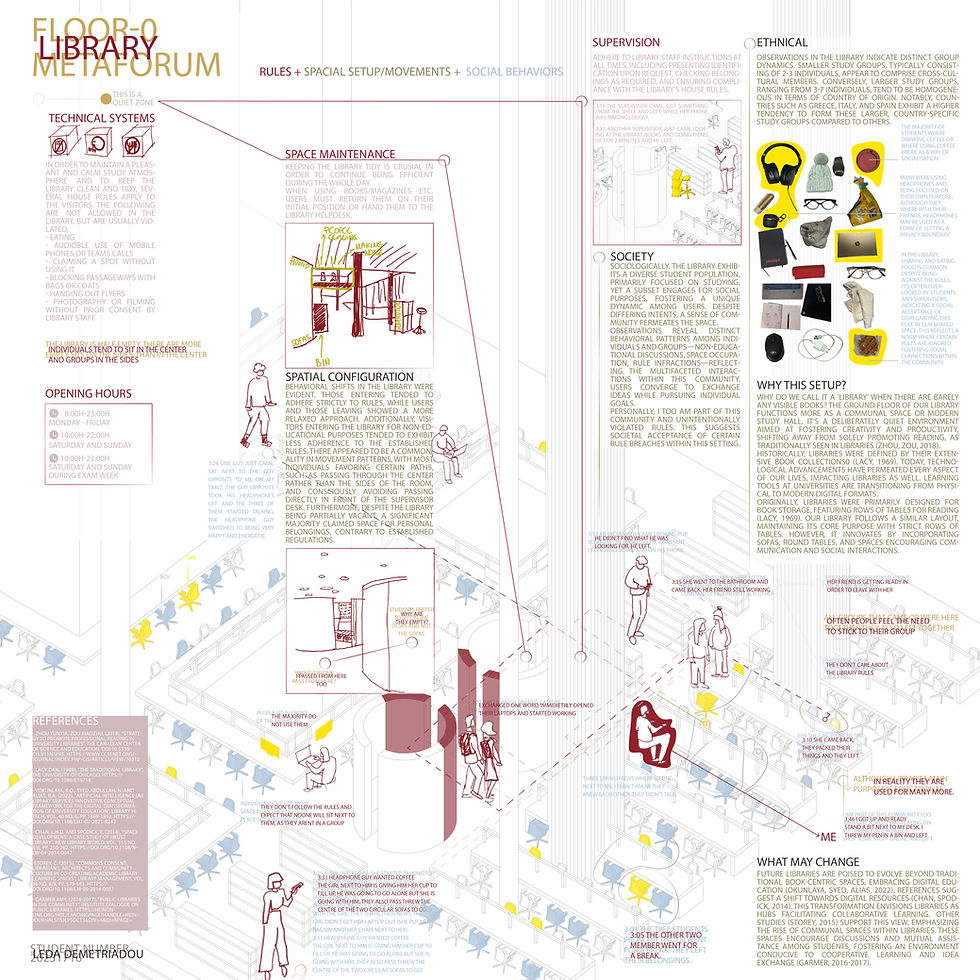'CommuniTEA'
Designer(s):
Leda Demetriadou, Stefanie Zins, Isidoros Kotinis
Professor(s):
Gabriele Ferri, Caroline Hummels, Daisy Yoo, Sander van Zwan
Year:
2024
Client:
Vestide
This course involved addressing the missing elements needed to form a society and rethinking space from a different perspective. The incorporation of social design methods, including Lo-TEK [1], further emphasized the potential of communal spaces to connect with nature and foster socialization.
Initially, this course involved the ethnographic research and infographic poster making methods, in order to identify and analyse societies formed around us, their behaviour and their changes and the correlation between the formation of societies and the space around them. Therefore, this research was done by note-taking, observing, mapping existing practices and creating infographic maps in order to be able to spot, as a next step, the missing elements that could stimulate communication and socialization and suggest ways to enhance that. It was very interesting conduct research about a space that I already know, Tue campus, from a different perspective.
Our design proposition suggests the socialization threw Tea, CommuniTEA events inside and out,
with the Lo-TEK [1] method. We utilize the entire allocated site, proposing the use of an interior space as a teahouse and other communal activities and allocating outdoor spaces for workshops, gatherings, when the weather allows it. This approach aimed to foster connections both with nature and among the community members.
Contribution to Development
The course exposed me to various societal companies and their functioning through lectures and workshops, providing opportunities to engage with owners and understand different types of societal organizations in order to better understand their perspectives and motives. I am intrigued by how daily routines affect living conditions and therefore I emphasize at the importance of designs that prioritize the user benefit, contributing not only to individual well-being but also to community welfare, and that is what I aim to be designing in the future. Through the Design for Social Innovation course, my understanding of the complex interplay between design, societal challenges, and technological progress has significantly grow. The course has been a transformative journey that allowed me to explore and internalize the principles of social innovation in the context of a complex modern society.
Moreover, I gained knowledge for the different social design approaches such as Lo-TEK [1], that we used in our proposition, as well as Participatory [2], Value Sensitive [3], Frame Creation [4], Critical design [5], [6] and Transforming Practices [7], [8], although a more in-depth exploration of these methods could have been beneficial.
This research offered me valuable insights, prompting me to observe more carefully the formed societies and groups around me, uncovering new details that had previously gone unnoticed. Multitude of societal challenges we face nowadays can be seen as signals of a need for a new paradigm. In addition, I discovered that the connection with nature by using practices for societal transformations such as the Lo-TEK [1] method can bring multicultural people together and stimulate conversation and socialisation.
In conclusion, the Design for Social Innovation course has been a transformative journey, shaping my identity as a designer by fostering a commitment to responsible and inclusive design practices, aiming to contribute positively to both individuals and communities. This course brought me closer to my goal of making a positive impact through responsible and inclusive design practices.


References
[1] J. Watson, Lo-TEK: Design by Radical Indigenism. Taschen, 2019.
[2] T. Binder, E. Brandt, P. Ehn, and J. Halse, “Democratic design experiments: between parliament and laboratory,” CoDesign, vol. 11, no. 3–4, pp. 152–165, 2015.
[3] B. Friedman, “Value-sensitive design,” interactions, vol. 3, no. 6, pp. 16–23, 1996.
[4] K. Dorst, “Frame creation and design in the expanded field,” She Ji: The Journal of Design, Economics, and Innovation, vol. 1, no. 1, pp. 22–33, 2015.
[5] B. Cadle and S. Kuhn, “Critical design as critique of the design status quo,” in Proc. 2013 DEFSA Conf. Proceedings: The Design Education Forum of Southern Africa, Sept. 2013, pp. 22–33.
[6] J. Bardzell and S. Bardzell, “What is ‘critical’ about critical design?,” in Proc. SIGCHI Conf. on Human Factors in Computing Systems, Apr. 2013, pp. 3297–3306.
[7] C. C. Hummels and P. D. Levy, “Education as a transforming practice: Designing together for complex, sustainable living,” in Relating Systems Thinking and Design Symposium: Playing with Tensions: Embracing New Complexity, Collaboration and Contexts in Systemic Design, Nov. 2021.
[8] A. Trotto, C. Hummels, P. Lévy, J. Peeters, R. van der Veen, D. Yoo, et al., “Designing for transforming practices: Maps and journeys,” 2021.